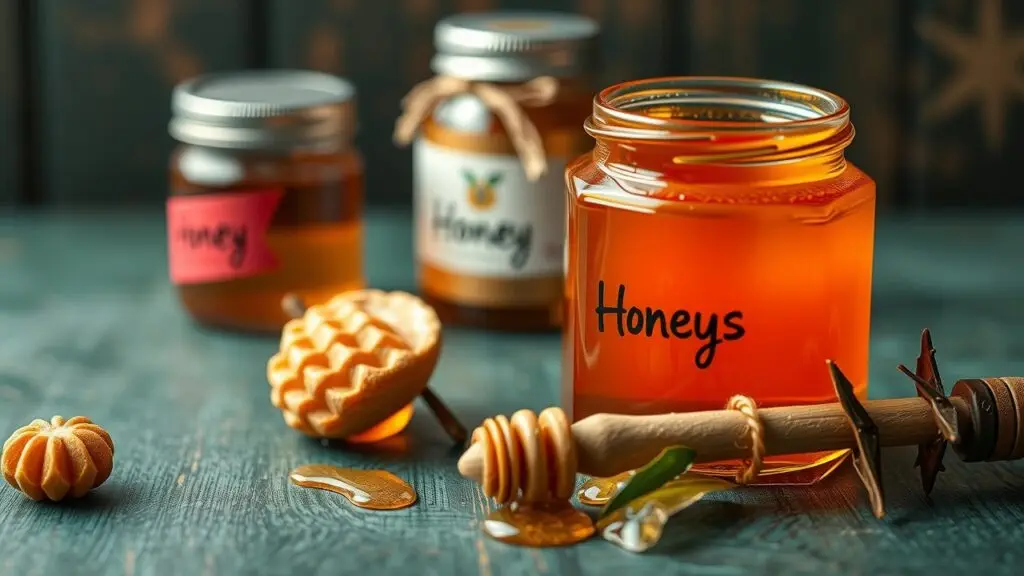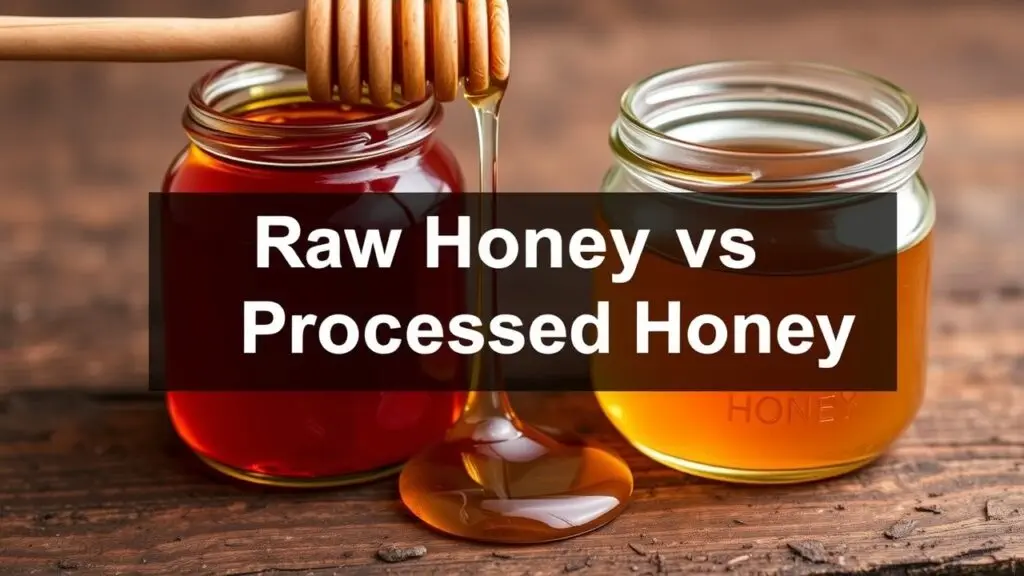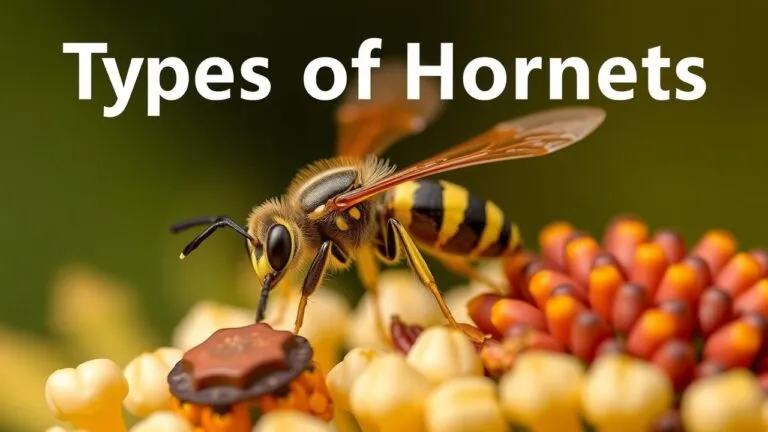Types of honey vary widely depending on the honey bee species and the flowers they pollinate. This guide explores different honey types, their unique flavors, and the bee species responsible for their production.
What is Honey?

Honey is a natural sweetener made by bees from the nectar of flowers. Bees collect this sugary liquid and bring it back to their hives. There, they turn it into honey through a process that includes enzymes and evaporation.
Honey mainly consists of sugars like fructose and glucose, which make up about 80% of it. It also has water, about 17%, along with some enzymes that help with digestion, minerals like calcium and iron, vitamins, and antioxidants. These parts give honey its sweetness and unique flavor.
Knowing what honey is made of helps us see its value beyond just being food. It can have health benefits too! For example, some studies say honey might soothe sore throats or act as an antioxidant.
Why Are There Different Types of Honey?
There are many types of honey because different flowers influence its flavor, color, and texture. When bees visit various flowers to collect nectar, each flower type adds its own special characteristics based on what’s in its nectar.
Here are some examples:
- Clover Honey: Light color and mild taste.
- Wildflower Honey: Darker with complex flavors from many flowers.
- Buckwheat Honey: Very dark and has strong molasses-like flavors.
Different bee species also play a role in producing various qualities and tastes in honey due to their foraging habits. This variety offers consumers exciting options for cooking or baking.
Importance of Choosing the Right Type of Honey
Choosing the right type of honey can make your cooking or baking better. Each variety adds unique flavors that can change how your dishes taste:
- Cooking Uses: Some honeys fit certain recipes better than others. For example, wildflower honey works great for marinades because it adds boldness.
- Baking Varieties: Different types provide moisture or sweetness needed in baked goods. Clover honey might be best for cakes while buckwheat adds depth to bread.
- Medicinal Benefits: Some honeys have health advantages—like manuka honey known for its antibacterial properties or local raw honeys that may help with allergies by exposing you to local pollen.
By understanding the differences among types of honey available today—from light floral notes to rich caramel undertones—you can pick the best ones that suit your needs!
Classification of Honey Types Based on Floral Source
Monofloral Honeys Explained
Monofloral honeys come from the nectar of one type of flower. Each variety has its own special taste and qualities. Here are some common types:
- Clover Honey: This honey is sweet and light amber. It has a smooth feel. You can use it in tea or to sweeten baked goods.
- Orange Blossom Honey: This honey tastes citrusy and has a medium amber color. It’s great for desserts or cocktails, adding a fun flavor to recipes.
- Lavender Honey: Lavender honey has a strong floral scent and is slightly sweet. It works well in herbal teas and pastries. Plus, many people like it for its calming smell in skincare products.
Multifloral Honeys Explained
Multifloral honeys are made from nectar collected by bees from many flowers. A popular example is:
- Wildflower Honey: This honey has rich flavors because it comes from many different plants. Depending on where it’s collected—like mountains or meadows—it can taste and look different each time.
Additional Considerations
When you think about the different types of honey based on floral sources, think about how they can be used in cooking and their health perks. Each type has something special to offer. Whether you’re baking cookies or trying natural remedies, knowing your options helps you pick the right honey for your needs!
Unique Regional Varieties & Specialty Honeys
Regional Highlights
Manuka Honey (New Zealand/Australia)
Manuka honey is dark and has a rich, earthy flavor. It comes from the Manuka tree found in New Zealand and Australia. People love it not just for its taste but also for its health perks. The Unique Manuka Factor (UMF) rating system shows how strong its antibacterial properties are. Higher UMF numbers mean better antimicrobial effects, making this honey popular for natural remedies.
Buckwheat Honey (North America/Europe)
Buckwheat honey is known for its strong taste and a hint of bitterness. Its dark brown color is perfect for marinades and dressings. Bees make this honey by collecting nectar from buckwheat flowers found mostly in North America and Europe. This honey is also packed with antioxidants, giving it extra health benefits while adding flavor to your meals.
Other Specialty Honeys
Acacia/Robinia Tree-Based Varieties
Acacia honey is light in color and has a mild flavor due to its high fructose content. This sweetness makes it great for sweetening drinks or drizzling over desserts without being too overpowering. Bees gather nectar from acacia trees, sticking to these flowers during their blooming time.
Leatherwood Honey
This honey comes from Tasmania’s leatherwood trees. It has a unique flavor and aroma that many people enjoy. Leatherwood honey is smooth and rich in antioxidants, which can help support overall health when added to your diet.
Sourwood Honey
Sourwood honey is sweet but also has a tangy kick from sourwood tree blossoms. These trees grow mainly in the Appalachian region of North America. Many people look for sourwood honey because of its distinct taste and possible health benefits, like reducing inflammation.
These unique varieties show just a few types of honey from around the world. Each type has its own special flavors and health benefits that can make your cooking or baking even better!
Understanding Honey Color, Flavor, and Texture
Honey is a sweet treat that comes in many types. Each type has its own special look, taste, and feel. The way honey looks and tastes depends a lot on the flowers that bees visit. Let’s look at these things so you can know what makes each kind of honey unique.
Honey Color Chart
Honey can be many colors! It can be light yellow or dark brown. The color often shows what kind of flowers the bees used to make it. Here’s a simple chart of some common honey colors:
| Honey Type | Color |
|---|---|
| Clover Honey | Light Amber |
| Wildflower Honey | Golden Yellow |
| Buckwheat Honey | Dark Brown |
| Orange Blossom Honey | Light Amber |
Lighter honey is usually sweeter and milder. Darker honey tends to have richer flavors.
Honey Flavor Profiles
Each type of honey has its own flavor that comes from the flowers it’s made from. Here are some examples:
- Clover Honey: This one is mild and sweet. It’s great for everyday use.
- Wildflower Honey: This is a mix from many flowers. It has a complex taste with fruity or spicy hints.
- Buckwheat Honey: This one is strong and bold. It can taste a bit malty.
These flavors mean different honeys work better for different foods, like baking or adding to yogurt.
Honey Texture Variations
The texture of honey can change a lot too! This depends on how much water it has and how it’s processed:
- Runny vs. Thick: Some honeys are runny because they have more water, like clover honey. Others are thick, like buckwheat honey.
- Crystallized Honey: Over time, many honeys can turn into crystals because sugar separates from water.
Knowing about these textures helps you pick the best type for your recipes or personal likes.
The Impact of Processing on Honey Characteristics
How honey is processed can really change its flavor and texture:
Raw vs. Processed Honeys:
- Raw honey isn’t filtered much, so it keeps all its natural goodness and may have bits of pollen.
- Processed honey gets heated and filtered. This removes impurities but can change how it tastes.
Choosing between raw or processed honey depends on your health goals and how you want to use it in cooking or baking.
By learning about different types of honey through their color, flavors, textures, and processing methods, you can find the perfect one for your needs!
Raw Honey vs. Processed Honey: A Detailed Comparison
Production Methods
Raw honey and processed honey are made in different ways. Raw honey comes straight from beehives. It has little processing, which means it keeps its natural enzymes, pollen, and nutrients. Beekeepers use a centrifuge to spin the honey out of the frames without heating or filtering too much.
Processed honey goes through more steps. It often gets heated, called pasteurization, and filtered. This helps it last longer and stops it from crystallizing. But these processes also take away some good things like pollen and antioxidants. Knowing how these two types are made can help you decide which one fits your taste and health needs better.
Taste, Texture, and Aroma Differences
The tastes of raw and processed honey can be quite different. Raw honey often has a rich flavor with various floral notes based on where the bees have been. It’s usually thicker and might have tiny bits of wax or pollen in it.
On the other hand, processed honey is smoother because it gets filtered to remove bits. This can make its flavor more uniform but less exciting than raw honey. The smell is also different—raw honey often smells stronger because of its flowers, while processed honey has a milder scent.
Health Implications
Both types of honey have health benefits but are not the same in how strong those benefits are. Raw honey has lots of antioxidants that help fight free radicals in our bodies. These antioxidants can boost your overall health if you eat them regularly.
Raw honey also has live enzymes that help with digestion. These enzymes can get damaged during the heating process that processed honey goes through. Some studies even suggest that eating local raw honey can help with seasonal allergies since it exposes you to local pollen bit by bit.
Nutrient Retention
When we look at the nutrients in raw versus processed honey, research shows that raw honey usually has more vitamins like B vitamins and important minerals such as calcium and iron than processed honey does.
Both types give energy mainly from sugars (fructose and glucose). But if you want the most nutrients, it’s better to pick raw varieties whenever you can for better nutrient retention overall.
Identifying High-Quality Honey

Visual Inspection
When you want to pick good honey, start with a visual check. Look for clear honey that shines. It should not have any floating bits or cloudiness. Honey comes in many colors, from light amber to dark brown. Lighter honey usually tastes milder, while darker types have stronger flavors.
Crystallization is something to notice too. A little bit of crystallization is normal and does not mean the honey is bad. But if there’s a lot, it could mean the honey was stored wrong or is old. Raw honey can crystallize quicker than processed honey because it has natural enzymes and pollen.
Taste and Aroma Testing
Next, it’s time for taste testing! High-quality honey has a unique flavor and smell. When you taste it, pay attention to what you feel and smell. Good honey can be sweet, fruity, floral, or even a bit spicy.
Try swirling the honey in your mouth before swallowing. This helps bring out all the flavors and smells. If the honey leaves a nice aftertaste without any bitterness, that’s a sign of quality.
Certifications
Certifications help you know if the honey is high-quality. Look for labels like “organic.” This means no harsh chemicals were used on the flowers where bees collected nectar.
Also check for raw honey certification. Raw honey is not heavily processed, so it keeps more nutrients than filtered varieties do.
Considering the Source
The source of your honey is super important for quality too. Ethical beekeeping means bees are treated well while producing delicious honey without harming nature.
Buying local honey is often best! It helps farmers near you and cuts down on pollution from transporting products over long distances. Plus, local honey may help with allergies by slowly exposing you to local pollen!
Additional Factors for Quality Assessment
Honey Viscosity: The thickness of the honey can show how fresh it is! Freshly harvested honey flows nicely when poured from a jar. If it’s thick and sticky, it might be older.
Honey Crystallization: Just because honey crystallizes doesn’t make it bad! This can happen naturally as time passes. Crystallized honey will feel grainy but still taste sweet! Different flowers create different types of crystallized honey that can add to its charm!
Using Honey: A Practical Guide
Honey Storage
Storing honey correctly helps keep its quality high over time. It’s best to keep it in a cool place away from sunlight in an airtight container. This prevents moisture from getting in, which could spoil the honey. Good news! Honey lasts a long time because of its low moisture content; if stored well, it won’t go bad.
Honey Crystallization
Sometimes, your honey may turn into crystals over time. This happens naturally and shows your honey is pure! If this occurs, don’t panic; crystallized honey still tastes good! You can fix it by warming the jar in hot water until it melts back into liquid form—just be careful not to heat it too much, as that might ruin some of its beneficial properties.
Honey Substitutions in Recipes
If you run out of a certain type of honey while cooking or baking, there are other sweet options! For example, agave nectar can be used as a sweetener that tastes similar but may change flavors a bit compared to regular honey used in recipes. Always think about how these alternatives might affect your dish before swapping them out!
Honey Bee Species and Their Impact on Honey
Overview of Major Honeybee Species
There are many honeybee species that help make honey around the world. The most well-known one is Apis mellifera, or the Western honeybee. You can find it in Europe, North America, and parts of Asia. This bee is very adaptable and can produce a lot of honey because it forages efficiently.
Another important species is Apis cerana, which is also called the Asian honeybee. It lives in warm climates across Asia and has developed some resistance to pests. While it makes less honey than Apis mellifera, it plays an important role in local ecosystems by helping with pollination.
Apis dorsata, known as the giant honeybee, typically lives in Southeast Asia. These bees build their nests high up in trees and are famous for producing large amounts of dark-colored honey that has a unique taste.
The smaller Apis florea, or dwarf honeybee, also likes tropical areas but prefers gardens and fields. It produces less honey than larger species but helps maintain local biodiversity.
Besides these types, there are stingless bees like Melipona irridipennis and the genus Trigona. They produce “bush” or “stingless bee” honey. This type has special flavors depending on the flowers they visit, but they don’t produce as much as the stinging bees.
Each bee species not only affects how much honey they make but also influences its taste and appearance based on their environment and flower choices.
How Bee Species Influence Honey Characteristics?
Different types of bees can change the flavor and color of honeys they create. For example, Apis mellifera gathers nectar from many types of flowers because of its floral fidelity, meaning it sticks to one type of flower at a time. This leads to varied flavors based on what blooms are available during different seasons.
On the other hand, Apis cerana often focuses more on specific plants that grow in its area. This can create unique tastes that reflect local flowers. The color of the honey might also be lighter or darker depending on what flowers are blooming at different times.
Honey from Apis dorsata usually has richer colors because these bees often collect nectar from deep-rooted rainforest plants. This makes the honey darker and gives it complex flavors that remind some people of caramel or molasses.
Stingless bee honeys bring another twist! For instance, honeys from Melipona spp. taste sweet with tangy notes from unique plants like certain fruit trees found only in specific places. That makes these varieties especially sought after by those who enjoy trying different kinds of honey!
The Importance of Bee Diversity
Having a variety of bee species is really important for both beekeeping and our ecosystem. Different bees help with pollinating different crops, which keeps our food systems strong. Also, having many types of bees helps ensure genetic diversity that fights diseases affecting hives around the world.
Sustainable beekeeping practices promote responsible methods to protect these essential insects’ natural homes while encouraging safe harvesting practices for their products so future generations can enjoy all the benefits of diverse honeys!
By learning how each type impacts both nature’s balance and our food systems—from fruits we eat to beautiful flowers—we see why it’s crucial to keep every bee around!
Frequently Asked Questions About Types of Honey
What are the most common types of honey?
The most common types of honey include Clover, Wildflower, Manuka, Buckwheat, and Orange Blossom. Each type has unique flavors based on its floral source.
How do honey colors relate to flavor?
Honey color can indicate flavor. Light honey tends to be milder and sweeter. Dark honey often has richer and bolder flavors.
What is the difference between raw and processed honey?
Raw honey is less processed and retains natural enzymes and nutrients. Processed honey is filtered and heated, which can alter its taste and remove some benefits.
How should I store honey?
Store honey in a cool, dark place in an airtight container. This helps maintain its quality and prevents it from crystallizing.
What are the health benefits of different types of honey?
Different types of honey have various health benefits. Manuka honey is known for its antibacterial properties. Local raw honeys may help with allergies by exposing you to local pollen.
Where can I find unique honey varieties?
You can find unique honeys at farmers’ markets, specialty stores, or online retailers. Look for local beekeepers for the best options.
Exploring Different Aspects of Honey
Honey Bee Species
- The Western honeybee (Apis mellifera) produces most commercial honey.
- The Asian honeybee (Apis cerana) plays a crucial role in local ecosystems.
- Giant honeybees (Apis dorsata) create large amounts of dark-colored honey.
- Dwarf honeybees (Apis florea) thrive in tropical areas but produce less honey.
Honey Production Process
- Beekeepers manage bee colonies in hives.
- Bees gather nectar from flowers through pollination.
- Honey is extracted from frames during harvesting.
- Various processing techniques can enhance or alter characteristics.
Honey Types by Region
- Manuka originates from New Zealand and Australia.
- Clover is popular in North America.
- Buckwheat is primarily found in Europe and parts of North America.
- Lavender flourishes in Mediterranean regions, enhancing its flavor.
Nutritional Value of Honey
- Honey provides natural sugars for quick energy.
- It contains antioxidants that may promote overall health.
- Some types offer antimicrobial properties beneficial for healing.
Cooking with Honey
- Use lighter honeys for sweetening tea or desserts.
- Darker varieties work well in marinades or baked goods for added depth.
- Experiment with different honeys to enhance flavor profiles in recipes.
Related Topics
- types of honeybees
- types of honey production
- types of honey flavor profiles
- types of honey by region
- types of honey storage methods
- types of honey certifications
- types of honey crystallization
- types of honey health benefits
- types of honey uses in cooking
- types of honey substitutes



Types of Honey: A Complete Guide to Honey Bee Species & Flavors